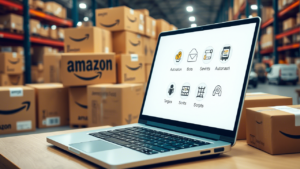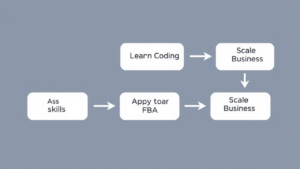Let’s face it: the world of e-commerce is changing faster than ever. By 2025, if you’re not leveraging tools like Amazon FBA (Fulfillment by Amazon), you might as well be selling rotary phones in a smartphone world. But here’s the kicker—understanding this system isn’t just about logistics. It’s also about thinking like a software engineer, even if you started as a computer engineer. Stick with me, and I’ll explain why this shift matters—and how it can lead to massive success.
The Big Picture: Why Amazon FBA Leads Matter
Amazon FBA leads are like the secret sauce of e-commerce. They give you access to millions of potential customers who trust Amazon’s platform. Think about it: when was the last time you bought something online without checking reviews or delivery times? Exactly.
But here’s where it gets interesting. Transitioning from a computer engineer to a software engineer mindset can help you understand the algorithms behind Amazon’s search rankings. You don’t need to be a coding wizard overnight, but knowing how data flows and systems interact gives you an edge. For example, optimizing product listings using SEO principles (similar to writing clean code) can skyrocket your visibility.
So, what’s the takeaway? Amazon FBA leads bring customers to your doorstep—but your job is to make sure they stay. And that requires a blend of technical know-how and strategic thinking.

From Computer Engineer to Software Engineer: What’s the Difference?
Before we dive deeper, let’s clarify something. A computer engineer focuses on hardware and low-level programming. They design circuits, troubleshoot machines, and ensure physical systems work seamlessly. On the other hand, a software engineer builds applications, writes code, and solves problems through logic and creativity.
Here’s the twist: both roles share transferable skills. As a computer engineer, you already think analytically and solve complex problems. Transitioning to software engineering means applying those same skills to software development. This is super relevant for Amazon sellers because understanding software can help you automate tasks, analyze customer data, and improve efficiency.
For instance:
- Writing scripts to track inventory levels.
- Automating PPC campaigns to maximize ROI.
- Using APIs to integrate third-party tools with Amazon Seller Central.
See? You’re not just selling products—you’re building a tech-driven business.
Skills to Leverage During Your Career Change
Switching from a computer engineer to a software engineer doesn’t mean starting from scratch. Here are some key skills you already have that can ease the transition:
- Problem-Solving Mindset: Debugging hardware issues trains you to approach challenges methodically—a must-have for coding.
- Attention to Detail: Precision matters whether you’re designing circuits or writing Python loops.
- Logical Thinking: Algorithms are just another form of structured reasoning.
Now, here’s what you’ll want to learn:
- Coding Languages: Start with Python or JavaScript—they’re beginner-friendly and widely used.
- Data Analysis: Tools like SQL and Excel will help you crunch numbers and spot trends.
- Automation: Platforms like Zapier or custom scripts can save hours of manual work.

Step-by-Step Guide to Transitioning Roles
If you’re thinking, “This sounds cool, but where do I even start?”—don’t worry. Here’s a simple roadmap:
Step 1: Assess Your Current Skill Set
Take stock of what you already know. Are you comfortable with basic programming concepts? Great! That’s your foundation.
Step 2: Learn New Coding Skills
Dive into online courses. Start small—maybe one hour a day—and build momentum. Focus on languages like Python first since they’re versatile and easy to grasp.
Step 3: Apply What You Learn
Practice makes perfect. Try automating parts of your Amazon FBA business. For example, write a script to pull sales reports automatically.
Step 4: Network and Upskill
Join communities like GitHub or Stack Overflow. Surround yourself with people who inspire you. Also, consider getting certified in AWS or Google Cloud—it’s gold for any tech role.
Step 5: Update Your Resume
Highlight projects you’ve worked on, especially those related to automation or data analysis. Employers love seeing real-world applications.
Challenges You Might Face (And How to Overcome Them)
Let’s keep it real: switching careers isn’t all sunshine and rainbows. Here are some hurdles you might encounter—and how to tackle them:
- Imposter Syndrome: Feeling like you don’t belong? Join the club. Everyone feels this way at first. Just keep learning and reminding yourself of your progress.
- Time Management: Balancing a full-time job while studying can feel overwhelming. Create a schedule and stick to it. Even 30 minutes a day adds up over time.
- Learning Curve: Coding can seem intimidating at first. Break it down into bite-sized chunks. Celebrate small wins along the way.
Remember, every expert was once a beginner. Keep pushing forward!
Benefits of Combining Software Engineering with Amazon FBA
Here’s the magic formula: combine your new software engineering skills with Amazon FBA, and watch your business soar. Here’s why this duo works so well:
- Automation Saves Time: Imagine setting up bots to handle repetitive tasks like updating prices or managing orders. More free time = more focus on growth.
- Data-Driven Decisions: Analyze customer behavior to optimize listings, ads, and inventory. Numbers don’t lie!
- Scalability: With the right tools, scaling your business becomes easier. Whether you’re selling 100 units or 10,000, your systems won’t break a sweat.
It’s like upgrading from a bicycle to a Ferrari. Sure, you could pedal harder—but why bother when you can zoom ahead?
Real-Life Example: Sarah’s Journey from Hardware to Software
Meet Sarah. She started as a computer engineer working on embedded systems. After years of soldering circuits and debugging firmware, she decided to try her hand at Amazon FBA. At first, managing her store felt chaotic. Then, she realized her background gave her a unique advantage.
Sarah taught herself Python and built a tool to monitor keyword rankings. She automated her ad campaigns and used data analytics to refine her strategies. Fast forward two years, and her business generates six figures annually—all thanks to combining her engineering roots with newfound software skills.
Inspired yet? If Sarah can do it, so can you.
Tips for Staying Ahead in 2025
The e-commerce landscape will only get tougher by 2025. To stay competitive, follow these tips:
- Invest in AI Tools: Platforms like Jungle Scout or Helium 10 use AI to predict trends and optimize listings.
- Focus on Sustainability: Eco-friendly packaging and ethical sourcing appeal to modern consumers.
- Stay Updated: Follow blogs, podcasts, and forums about e-commerce and tech trends. Knowledge is power.
Bonus: Internal Link Placeholder – Check out our guide on [Top Tools for Amazon Sellers].
Conclusion:
Transitioning from a computer engineer to a software engineer isn’t just about changing jobs—it’s about unlocking new opportunities. When paired with Amazon FBA, these skills create a powerhouse combination that sets you apart in the crowded e-commerce space.
So, what are you waiting for? Start learning today. Enroll in a course, experiment with automation, and take the first step toward transforming your career—and your business.
FAQ
Q1: Is it hard to switch from computer engineering to software engineering?
Not necessarily! Many skills overlap, and there are tons of resources to help you learn coding quickly.
Q2: Do I need a formal education to become a software engineer?
Nope! While degrees help, self-taught engineers are common. Focus on practical experience and certifications instead.
Q3: How long does it take to learn enough coding for Amazon FBA?
Depending on your pace, 3-6 months should suffice to pick up basics like Python and data analysis.
Q4: Can I run an Amazon FBA business part-time?
Absolutely! Many successful sellers juggle full-time jobs while growing their stores.
Q5: What’s the best language to learn for Amazon FBA?
Python is ideal due to its simplicity and versatility for automation and data analysis.



